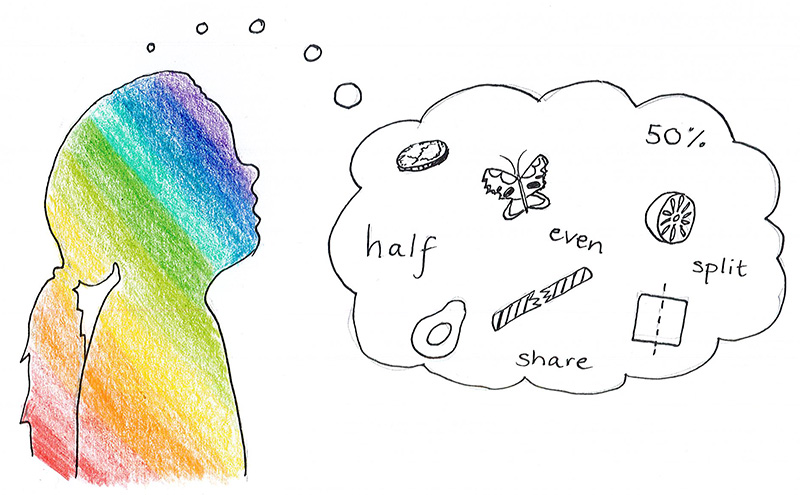Think of a fraction. It’s no surprise that most of us will immediately settle on a half – it’s the most commonly used fraction word in our everyday language and daily lives, and acts as a solid benchmark for most of us in terms of quantity comparisons. Imagine the number of times a young child hears the word ‘half’ every day: “it’s half-past seven”; “you are three-and-a-half years old”; “do you want me to cut your fish fingers in half?”; “you can have half each”; and so on…
I’ve noticed my four-year-old daughter using the word ‘half’ in a number of ways over the last few months and it’s made me think hard about the way in which, in the ‘real world’, ‘half’ is usually used in an approximate sense, its meaning tending to be about a sense of ‘middle’. We might say that the time is “half-past two” any time after 2:25 and before 2:35. We say that we cut the piece of cake in half to share it, and then select the ‘bigger half’ for ourselves! Measuring doesn’t usually come into it because estimating a half of something is much quicker, easier, and perfectly adequate in the majority of circumstances.
But then we enter the world of the mathematics classroom. A child casually tells the teacher that they’ve got half of the counters and are told that they’ve got it wrong! They’re asked to count them out; maybe they’ve got 5 and their friend has got 7. The teacher looks at them expectantly. But they don’t understand: half just means that you’re sharing something or cutting something in two and that’s what they’ve done. They’ve both got about the same amount so it’s just about fair, right? The concept of ‘one half’ meaning ‘one of two equal shares’ is a detail not recognised by many young children. Why would they know this? We very rarely talk about a half with a child at home in a way that requires anything other than quite a vague sense of ‘cutting down the middle’.
If ‘one half’ is important in the mathematics classroom then we need to spend time on the details. Sometimes there is a feeling that words used in mathematics have a different meaning to those used in the real world. But in this case, it’s that ‘half’ has a more precise meaning, connected to the concept of ‘division’ in which we are ‘dividing’ (or cutting, or sharing) a quantity into a number of equal parts. There’s also the part-whole comparisons that might take place: this quantity is half as much as this one because two identical copies fit into it.
Perhaps one of the subtler changes in meaning is to do with the nature of the quantity to be ‘halved’. In those early experiences of ‘half’, children are often dealing with essentially continuous quantities, for which dividing into two exactly equal pieces is not easy nor necessary. But, when dealing with discrete quantities like sweets or counters, there might be a need to think more carefully about the actual process of sharing – do we make an estimate based on ‘cutting’ the area down the middle, or do we use a dealing strategy, giving “one for you, one for me”? What do we do if there’s one left over?
One of the most beautiful things about a half is its flexibility. We can keep halving, again and again, relatively easily, and generate other fractions. This makes it a very powerful benchmark from which to make comparisons of both abstract numbers and physical quantities, and measures. Of course, we can do this with other fractions, but the apparent simplicity of ‘one half’ is appealing and useful.
Another wonderful thing about one half is its relationship to the idea of symmetry. I mistakenly opened a bizarre news story this morning with the headline: “Mystery as dead ‘crocodile’ found lying ‘cut in half’ on city footpath”, and immediately started to picture a crocodile and how exactly one would go about cutting it in half. To be clear, I wasn’t concerned with the macabre practicalities; no – I wanted to know how, in principle, you might cut it so as to get two equal pieces.
So now symmetry comes into play – as it does when cutting up a cake or a pizza or a chocolate bar. Our first ideas about this kind of division may involve some reflective symmetry. But, the two halves don’t have to be symmetrical, do they? They just need to be equal by some measure: probably in this case, by volume.
In the mathematics classroom, ‘half’ acts both as a powerful means of connecting concepts in number, measure, geometry and statistics, and as a gateway into the development of more formal rational number understanding. Given its significance, it would seem unfortunate if children did not have lots of opportunities to experience and to play with more of the many conceptions of ‘half’. This will surely enhance their general ‘sense of number’ and help to build the foundations of a strong network of connected knowledge that they can draw upon in more complex situations and when solving problems.

From crocodiles to lunch: I’ll leave you with the image of me ‘halving’ my daughter’s sandwich (which I inevitably do the ‘wrong’ way). I suggest that we remember that there’s more than two ways to cut said sandwich in half (whilst still maintaining a good conception of ‘half’ meaning one of two equal pieces or even composite shapes), and endless ways to make eating lunch a more exciting event! For a fun challenge, try estimating the diameter of the circular cutter that would be needed to make one half of a slice of standard bread (approx. 15cm across).
Join the conversation: You can tweet us @CambridgeMaths or comment below.